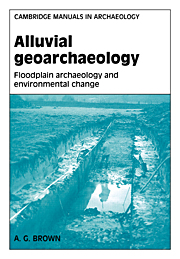Book contents
- Frontmatter
- Contents
- List of illustrations
- List of tables
- Preface
- Acknowledgements
- Introduction and the example of the Nile
- PART I PRINCIPLES
- PART II APPLICATION
- 5 Artifacts from floodplains and rivers
- 6 The rise and fall of forested floodplains in North-West Europe
- 7 Buried sites
- 8 Managed floodplains
- 9 The cultural archaeology of floodplains
- 10 People, floodplains and environmental change
- APPENDICES
- References
- Subject Index
- Index of rivers and sites
6 - The rise and fall of forested floodplains in North-West Europe
Published online by Cambridge University Press: 03 December 2009
- Frontmatter
- Contents
- List of illustrations
- List of tables
- Preface
- Acknowledgements
- Introduction and the example of the Nile
- PART I PRINCIPLES
- PART II APPLICATION
- 5 Artifacts from floodplains and rivers
- 6 The rise and fall of forested floodplains in North-West Europe
- 7 Buried sites
- 8 Managed floodplains
- 9 The cultural archaeology of floodplains
- 10 People, floodplains and environmental change
- APPENDICES
- References
- Subject Index
- Index of rivers and sites
Summary
Floodplain environments in North-West Europe changed profoundly at the end of the last glaciation and have continued to change, although less dramatically, during the Holocene. Climate change affected the hydrology, sedimentology and vegetation of floodplains. As the rivers and vegetation changed so did floodplain resources. From at the latest the Neolithic (c. 6000 bp) vegetation was also influenced by human activity. Thus floodplain history is the result of spatially variable interactions between people and natural factors such as climate change, ecological dynamics and soil development. This chapter uses selected examples of northern and central European rivers to outline changing floodplain environments from the Lateglacial to the Mid-Holocene. These environments include Lateglacial floodplains, the Early Holocene floodplain environments of Mesolithic gatherers-fishers-hunters (hereafter referred to as g-f-hs), and the land use changes of floodplains into the Neolithic and Bronze Ages. It would be impossible to cover comprehensively the whole of North-West Europe, or to provide a uniform temporal coverage, if only for reasons imposed by the pattern of Holocene floodplain evolution itself and because of the patchy distribution of research. Therefore, the approach has been to select some of the most informative studies, largely from the British Isles, which have a direct bearing on the archaeology of floodplains and their sites.
Floodplains in the Temperate and Boreal zones have changed dramatically since the glacial maximum c. 18,000 years ago.
- Type
- Chapter
- Information
- Alluvial GeoarchaeologyFloodplain Archaeology and Environmental Change, pp. 192 - 218Publisher: Cambridge University PressPrint publication year: 1997



